1、多条件查询
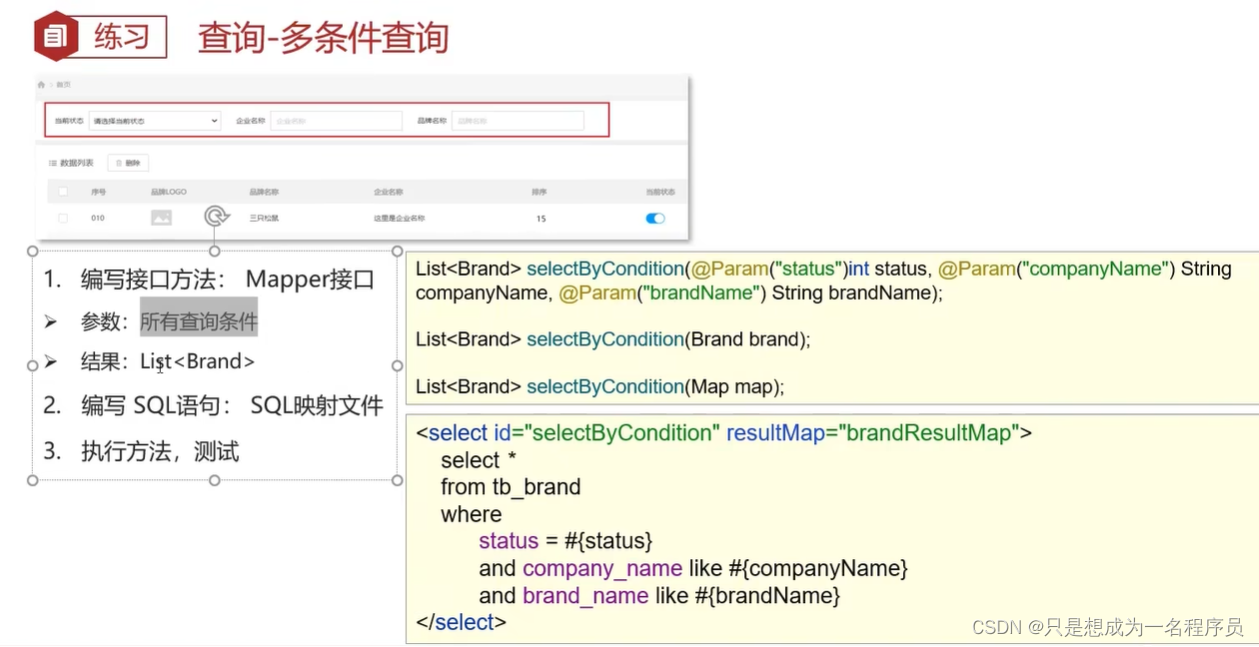

我们经常会遇到如上图所示的多条件查询,将多条件查询的结果展示在下方的数据列表中。而我们做这个功能需要分析最终
的SQL语句应该是什么样,思考两个问题
- 条件表达式
- 如何连接
条件字段 企业名称 和 品牌名称 需要进行模糊查询,所以条件应该是:

简单的分析后,我们来看功能实现的步骤:
编写接口方法
参数:所有查询条件
结果:List
在映射配置文件中编写SQL语句
编写测试方法并执行
1.1三种编写多条件查询的接口方法
在 BrandMapper 接口中定义多条件查询的方法。
而该功能有三个参数,我们就需要考虑定义接口时,参数应该如何定义。Mybatis针对多参数有多种实现
1.1.1 使用 @Param(“参数名称”) 标记每一个参数,在映射配置文件中就需要使用 #{参数名称} 进行占位
List<Brand> selectCondition(@Param("status") int status, @Param("companyName") String
companyName,@Param("brandName") String brandName);
1.1.2 将多个参数封装成一个实体对象,将该实体对象作为接口的方法参数。该方式要求在映射文件中的SQL中使用#{内容} 时,里面的内容必须和实体类的属性名保持一致。
List<Brand> selectCondition(Brand brand);
1.1.3 将多个参数封装到map集合中,将map集合作为接口的方法参数。该方式要求在映射配置文件的SQL中使用 #{内容}时,里面的内容必须和map集合中键的名称一致。
List<Brand> selectCondition(Map map);
1.2 编写SQL语句
在 BrandMapper.xml 映射配置文件中编写 statement ,使用 resultMap 而不是使用 resultType
<!-- 多条件查询sql映射 -->
<select id="selectCondition" resultMap="brandResultMap">
select * from tb_brand where
status = #{status} and
company_name like #{companyName} and
brand_name like #{brandName}
</select>
1.3 编写测试方法
@Test
public void testSelectByCondition() throws IOException {
//接收参数
int status = 1;
String companyName = "华为";
String brandName = "华为";
// 处理参数
companyName = "%" + companyName + "%";
brandName = "%" + brandName + "%";
//1. 获取SqlSessionFactory
String resource = "mybatis-config.xml";
InputStream inputStream = Resources.getResourceAsStream(resource);
SqlSessionFactory sqlSessionFactory = new SqlSessionFactoryBuilder().build(inputStream);
//2. 获取SqlSession对象
SqlSession sqlSession = sqlSessionFactory.openSession();
//3. 获取Mapper接口的代理对象
BrandMapper brandMapper = sqlSession.getMapper(BrandMapper.class);
//4. 执行方法
//方式一 :接口方法参数使用 @Param 方式调用的方法
//List<Brand> brands = brandMapper.selectCondition(status, companyName, brandName);
//方式二 :接口方法参数是 实体类对象 方式调用的方法
//封装对象
/* Brand brand = new Brand();
brand.setStatus(status);
brand.setCompanyName(companyName);
brand.setBrandName(brandName);*/
//List<Brand> brands = brandMapper.selectCondition(brand);
//方式三 :接口方法参数是 map集合对象 方式调用的方法
Map map = new HashMap();
map.put("status" , status);
map.put("companyName", companyName);
map.put("brandName" , brandName);
List<Brand> brands = brandMapper.selectCondition(map);
System.out.println(brands);
//5. 释放资源
sqlSession.close();
}
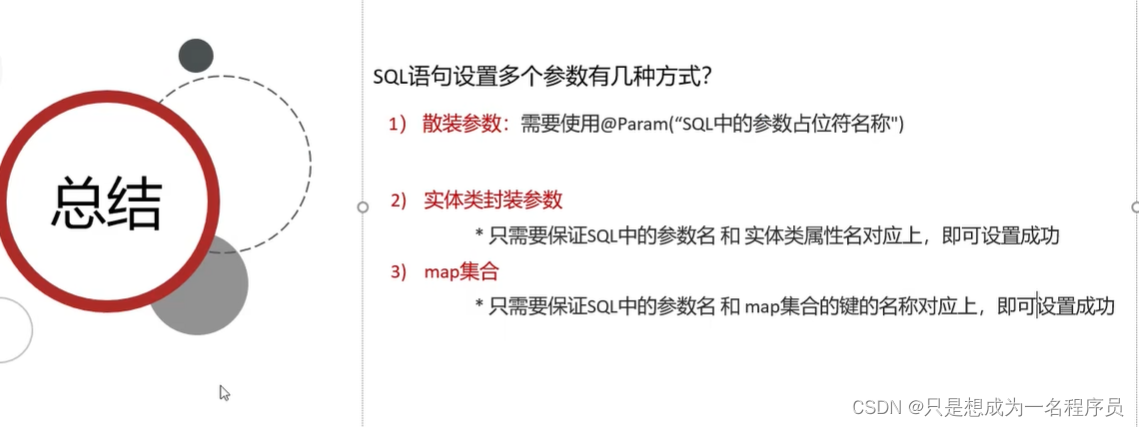
2、动态多条件查询–动态SQL
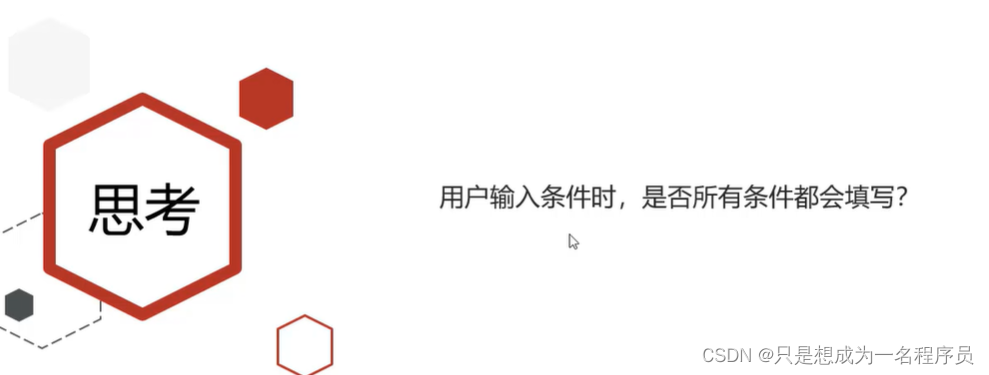
上述功能实现存在很大的问题。用户在输入条件时,肯定不会所有的条件都填写,这个时候我们的SQL语句就不能那样写的
例如用户只输入 当前状态 时,SQL语句就是
select * from tb_brand where status = #{status}
而用户如果只输入企业名称时,SQL语句就是
select * from tb_brand where company_name like #{companName}
而用户如果输入了 当前状态 和 企业名称 时,SQL语句又不一样
select * from tb_brand where status = #{status} and company_name like #{companName}
针对上述的需要,Mybatis对动态SQL有很强大的支撑:
- if
- choose (when, otherwise)
- trim (where, set)
- foreach
我们先学习 if 标签和 where 标签:
- if标签:条件判断
-test属性:逻辑表达式
<select id="selectCondition" resultMap="brandResultMap">
select * from tb_brand
where
<if test="status != null">
status = #{status}
</if>
<if test="companyName != null and companyName != ''">
and company_name like #{companyName}
</if>
<if test="brandName != null and brandName != ''">
and brand_name like #{brandName}
</if>
</select>
如上的这种SQL语句就会根据传递的参数值进行动态的拼接。如果此时status和companyName有值那么就会值拼接这
两个条件。

但是它也存在问题,如果此时给的参数值是
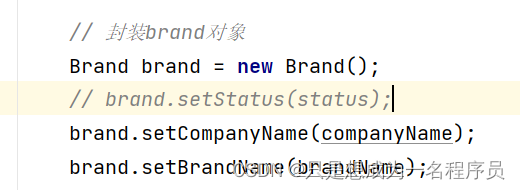
拼接的SQL语句就变成了
select * from tb_brand where and company_name like ? and brand_name like ?

而上面的语句中 where 关键后直接跟 and 关键字,这就是一条错误的SQL语句。这个就可以使用 where 标签解决
- where 标签
- 作用:
- 替换where关键字
- 会动态的去掉第一个条件前的 and
- 如果所有的参数没有值则不加where关键字
- 作用:
<select id="selectCondition" resultMap="brandResultMap">
select * from tb_brand
<where>
<if test="status != null">
and status = #{status}
</if>
<if test="companyName != null and companyName != ''">
and company_name like #{companyName}
</if>
<if test="brandName != null and brandName != ''">
and brand_name like #{brandName}
</if>
</where>
</select>

注意:需要给每个条件前都加上 and 关键字。
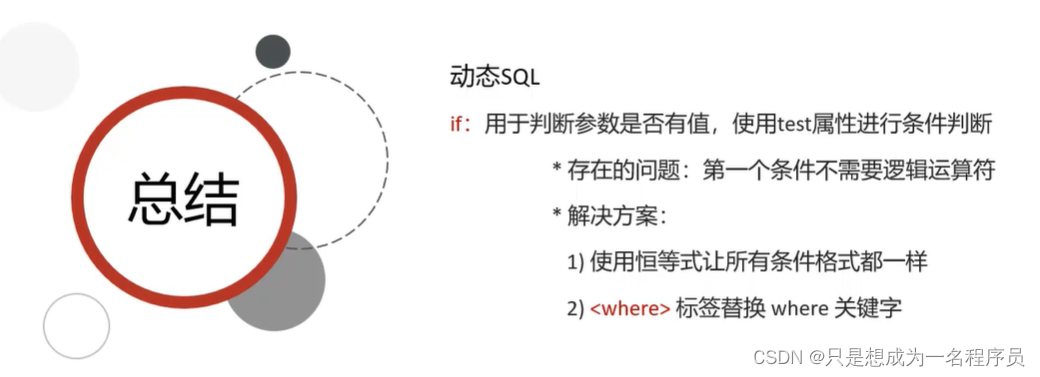
3、动态单条件查询 sql
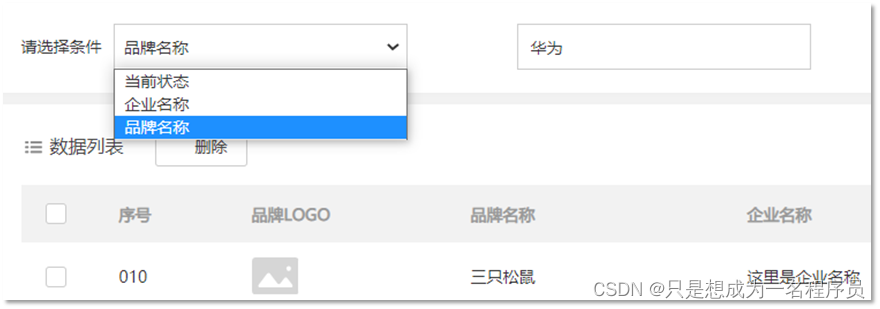
如上图所示,在查询时只能选择 品牌名称 、 当前状态 、 企业名称 这三个条件中的一个,但是用户到底选择哪儿一个,我们并
不能确定。这种就属于单个条件的动态SQL语句。
这种需求需要使用到 choose(when,otherwise)标签 实现, 而 choose 标签类似于Java 中的switch语句。
通过一个案例来使用这些标签
3.1 编写接口方法
在 BrandMapper 接口中定义单条件查询的方法。
/**
* 单条件动态查询
* @param brand
* @return
*/
List<Brand> selectBySingle(Brand brand);
3.2编写SQL语句
在 BrandMapper.xml 映射配置文件中编写 statement ,使用 resultMap 而不是使用 resultType
<!-- 动态单条件查询 choose when otherwise -->
<select id="selectBySingle" resultMap="brandResultMap">
select * from tb_brand
<where>
<choose><!-- 相当于switch -->
<when test="status !=null ">
status = #{status}
</when>
<when test="companyName != null and companyName != ''">
company_name like #{companyName}
</when>
<when test="brandName != null and brandName != ''">
brand_name like #{brandName}
</when>
</choose>
</where>
</select>
3.3编写接口方法
在 test/java 下的 com.itheima.mapper 包下的 MybatisTest类中 定义测试方法
@Test
public void selectBrandCondition() throws Exception {
// 0.传参数
int status = 1;
String companyName = "华为";
String brandName = "华为";
//0.1 添加模糊查询的条件
companyName = "%" + companyName + "%";
brandName = "%" + brandName + "%";
// 封装brand对象
Brand brand = new Brand();
// brand.setStatus(status);
// brand.setCompanyName(companyName);
brand.setBrandName(brandName);
//1、加载mybatis的核心配置文件,获取SqlSessionFactory
String resource = "mybatis-config.xml";//相对路径,基于resources
InputStream inputStream = Resources.getResourceAsStream(resource);
SqlSessionFactory sqlSessionFactory = new SqlSessionFactoryBuilder().build(inputStream);
//2.有了工厂对象,就要获取SqlSession对象,执行SQL语句。
SqlSession sqlSession = sqlSessionFactory.openSession();
//3.执行sql,实参名字是sql的mapper.xml命名空间.id标识
// List<User> users = sqlSession.selectList("test.selectAll");
//3.执行sql获取UserMapper接口的代理对象
BrandMapper brandMapper = sqlSession.getMapper(BrandMapper.class);
// List<Brand> brands = brandMapper.selectCondition(status,companyName,brandName);
List<Brand> brands = brandMapper.selectBySingle(brand);
//4.输出
//[Brand{id=2, brandName='华为', companyName='华为技术有限公司', ordered=100, description='化为牛B', status=1}]
System.out.println(brands);
//5.释放资源
sqlSession.close();
}
























 2248
2248











 被折叠的 条评论
为什么被折叠?
被折叠的 条评论
为什么被折叠?








